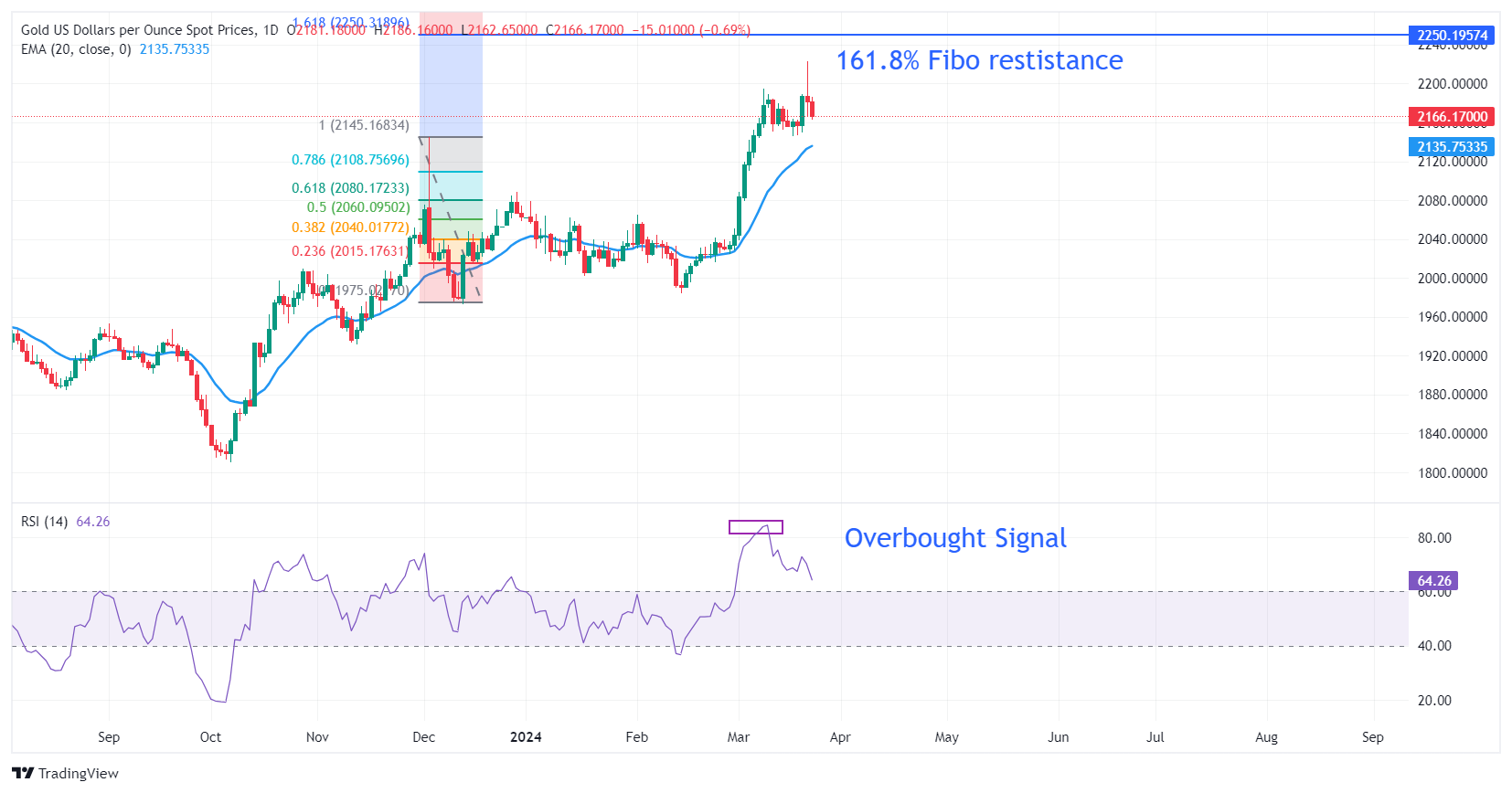- The price of Gold fails to maintain all-time highs around $2,220, while the US Dollar strengthens.
- The dollar takes advantage of the solid US economic outlook.
- The Fed's rate cut campaign could be less aggressive than that of other central banks in developed countries.
The price of Gold (XAU/USD) extends its decline to around $2,160 in the American session on Friday after failing to stay close to its all-time highs above $2,220. The precious metal faces sharp selling as the US dollar strengthens on the optimistic US economic outlook, bolstered by strong existing home sales data released on Thursday. The US Dollar Index (DXY) refreshes a monthly high at 104.41.
Dollar-denominated Gold tends to suffer liquidity outflows when the Dollar strengthens. The outlook for the US economy improved after the Federal Reserve revised upward growth forecasts for 2024. The Fed sees US Gross Domestic Product (GDP) growing 2.1%, up from 1.4% forecast in December.
The 10-year US Treasury yield falls to 4.24% as the Fed reiterated on Wednesday that it expects three interest rate cuts this year. Fed officials maintained their December forecasts even though consumer and producer price inflation remained persistent in February. US bond yields remain within Thursday's fluctuation range, awaiting new stimulus.
Daily Market Summary: Gold Price Pressured by Strong US Dollar
- The price of Gold is pressured by the strength of the US Dollar. The attractiveness of the Dollar strengthened after the Swiss National Bank (SNB) emerged as the leader of the global cycle of rate cuts. On Thursday, the SNB unexpectedly reduced interest rates by 25 basis points (bp), to 1.50%. This has increased optimism among market participants that other central banks will follow suit, particularly in economies where inflation is slowing and recession risks are high.
- The European Central Bank (ECB), the Bank of England and the Bank of Canada (BoC) are also expected to begin considering rate cuts soon. Given its poor economic outlook, rate cuts could be aggressive in the long term.
- Like other central banks, market participants expect the Federal Reserve to also begin cutting interest rates this year. However, the Fed is not expected to rush to cut rates as US inflation is persistent and the country's economic outlook is optimistic. The U.S. economy is on firm footing based on consumer spending and the labor market, giving the Fed time to look at more data before moving to cuts.
- This week, the price of gold saw a sharp rally after the Fed maintained its forecast for three rate cuts by 2024. Fed Chair Jerome Powell said in his monetary policy statement that the story of easing Price pressures are intact despite recent hot inflation readings.
- Although the Fed maintained its forecast for three rate cuts, it made clear that they would only be appropriate if it has greater confidence that inflation will decline sustainably to the 2% target. Non-interest-paying assets, like Gold, face downward pressure when the Fed keeps interest rates higher for a longer period.
Technical Analysis: Gold Price Falls as Oscillators Become Overbought

The price of Gold falls significantly to $2,162 from its all-time high of $2,222. Profit taking dragged down Gold price as momentum oscillators became extremely overbought on the daily time frame. This does not show a bearish reversal as the asset could bounce after the oscillators cool down. The 14-period Relative Strength Index (RSI) falls after settling slightly above 84.00. The RSI (14) is considered extremely overbought when it exceeds 80.00.
Short-term demand for the price of Gold remains strong as the 20-day EMA at $2,137 tilts higher.
To the upside, Gold price could face resistance near the 161.8% Fibonacci extension at $2,250. The Fibonacci tool is plotted from the December 4 high at $2,144.48 to the December 13 low at $1,973.13. On the downside, the December 4 high at $2,144.48 will support the Gold price bulls.
Frequently asked questions about Gold
Why invest in Gold?
Gold has played a fundamental role in human history, as it has been widely used as a store of value and medium of exchange. Today, aside from its brilliance and use for jewelry, the precious metal is considered a safe-haven asset, meaning it is considered a good investment in turbulent times. Gold is also considered a hedge against inflation and currency depreciation, since it does not depend on any specific issuer or government.
Who buys more Gold?
Central banks are the largest holders of Gold. In their aim to support their currencies in turbulent times, central banks tend to diversify their reserves and purchase Gold to improve the perception of strength of the economy and currency. High Gold reserves can be a source of confidence for the solvency of a country. Central banks added 1,136 tons of gold worth about $70 billion to their reserves in 2022, according to data from the World Gold Council. This is the largest annual purchase since records exist. Central banks in emerging economies such as China, India and Turkey are rapidly increasing their gold reserves.
What correlation does Gold have with other assets?
Gold has an inverse correlation with the US Dollar and US Treasuries, which are the main reserve and safe haven assets. When the Dollar depreciates, the price of Gold tends to rise, allowing investors and central banks to diversify their assets in turbulent times. Gold is also inversely correlated with risk assets. A rally in the stock market tends to weaken the price of Gold, while sell-offs in riskier markets tend to favor the precious metal.
What does the price of Gold depend on?
The price of Gold can move due to a wide range of factors. Geopolitical instability or fear of a deep recession can cause the price of Gold to rise rapidly due to its status as a safe haven asset. As a non-yielding asset, the price of Gold tends to rise when interest rates fall, while rising money prices tend to weigh down the yellow metal. Still, most of the moves depend on how the US Dollar (USD) performs, as the asset is traded in dollars (XAU/USD). A strong Dollar tends to keep the price of Gold in check, while a weaker Dollar is likely to push up Gold prices.
Source: Fx Street
I am Joshua Winder, a senior-level journalist and editor at World Stock Market. I specialize in covering news related to the stock market and economic trends. With more than 8 years of experience in this field, I have become an expert in financial reporting.







